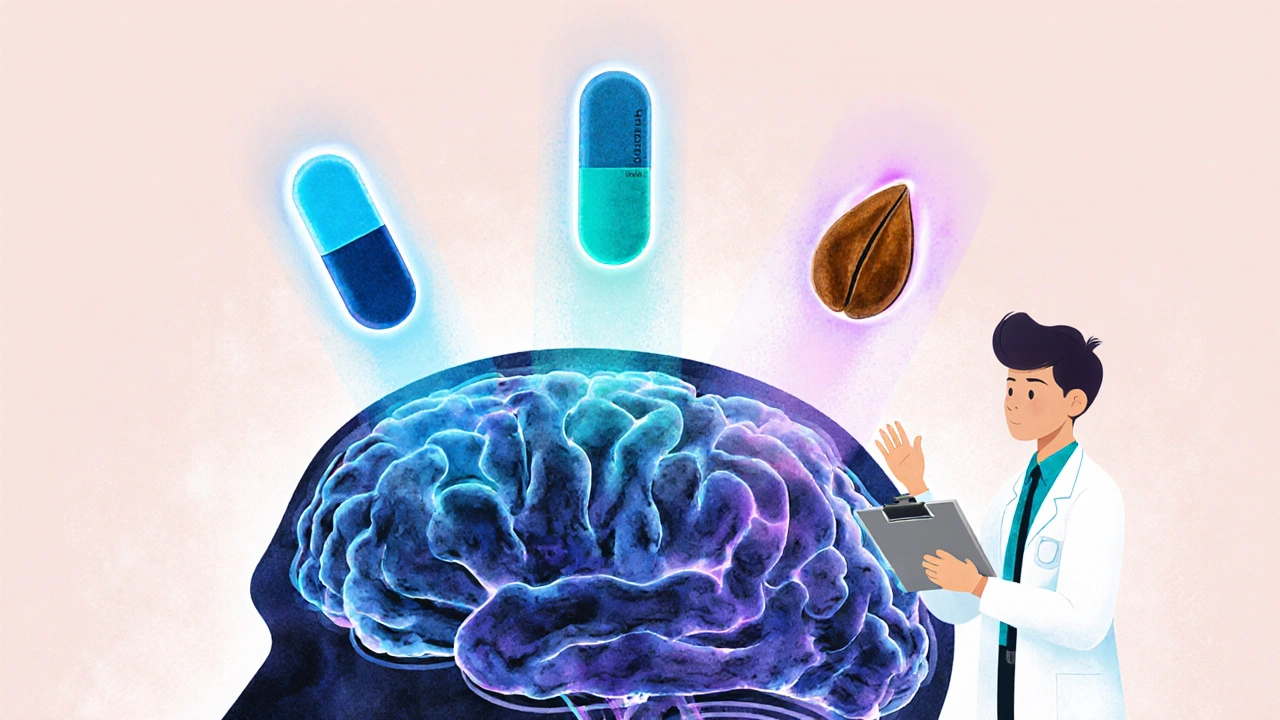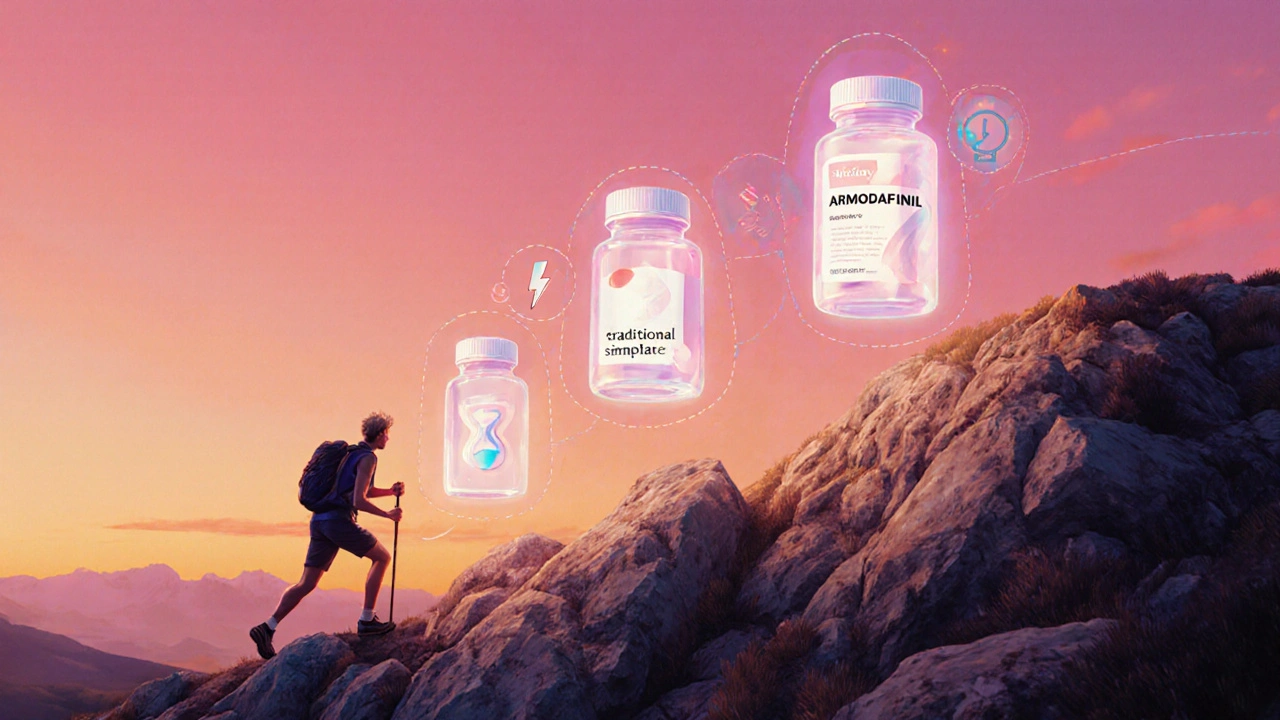Wakefulness Medication Comparison Tool
Select your criteria to compare wakefulness medications:
12 hours Moderate ModerateQuick Summary
- Armodafinil comparison: offers longer-lasting alertness with fewer peaks than modafinil, but requires a prescription.
- Modafinil is cheaper and widely available, yet may wear off sooner for some users.
- Adrafinil works without a prescription but needs liver conversion and can stress the liver.
- Caffeine is the cheapest, over‑the‑counter option but causes jitters and crashes.
- Prescription stimulants (methylphenidate, amphetamine) are powerful but carry higher abuse risk and cardiovascular warnings.
When it comes to staying alert during long work hours or managing narcolepsy, Armodafinil is a prescription medication that promotes wakefulness. It is the R‑enantiomer of modafinil, meaning it contains only the active “right‑handed” molecule, which can provide a smoother onset and longer half‑life compared with its sibling. The drug is approved in the U.S., EU, and many other regions for narcolepsy, shift‑work sleep disorder, and obstructive sleep apnea‑related daytime sleepiness. If you’re weighing it against other options, you’ll want to understand how its mechanism, dosing, side‑effects, and legal status stack up.
How Armodafinil Works
Armodafinil belongs to the class of eugeroics-agents that promote wakefulness without the classic “high” of traditional stimulants. It primarily blocks the reuptake of dopamine, boosting extracellular dopamine levels in the brain’s hypothalamus. This modest dopamine rise improves alertness while sparing the strong sympathomimetic effects that cause rapid heart‑rate spikes in amphetamines.
Because it contains only the more active enantiomer, the drug’s half‑life averages 15hours, giving users a smoother, longer‑lasting effect than its racemic counterpart. Most patients notice peak alertness around 2‑3hours after dosing, with a gradual taper that helps avoid the afternoon crash.
Common Alternatives Overview
Below are the most frequently discussed wake‑promoting agents, each introduced with basic attributes.
- Modafinil - the racemic mixture of which armodafinil is the active half. Generally cheaper, but may wear off a bit earlier.
- Adrafinil - an over‑the‑counter pro‑drug that liver‑converts to modafinil. No prescription needed, but long‑term liver health can be a concern.
- Caffeine - the world’s most popular stimulant found in coffee, tea, and pills. Fast acting, short duration, and easily tolerated.
- Methylphenidate - a prescription stimulant (e.g., Ritalin) used for ADHD. Strong alertness boost but higher abuse potential.
- Amphetamine - includes mixed amphetamine salts (Adderall) and dextro‑amphetamine. Very effective for wakefulness, yet carries cardiovascular warnings.
- Pitolisant - a newer histamine‑2 receptor inverse agonist approved in Europe for narcolepsy. Works via a different pathway than dopaminergic agents.
- Sodium Oxybate - primarily a nighttime sleep‑inducing drug (Xyrem) that paradoxically improves daytime alertness in narcolepsy patients.

Head‑to‑Head Comparison
| Drug | Class | Typical Dose | Duration of Effect | Regulatory Status | Major Pros | Major Cons |
|---|---|---|---|---|---|---|
| Armodafinil | Eugeroic | 150mg once daily | 12‑15hrs | Prescription (US, EU, AU) | Longer lasting, smoother onset, lower abuse potential | Requires prescription, cost higher than modafinil |
| Modafinil | Eugeroic | 200mg once daily | 10‑12hrs | Prescription (most countries) | Cheaper, widely available | Shorter half‑life, slightly more peak‑effect side‑effects |
| Adrafinil | Pro‑drug (modafinil) | 300mg once daily | ~10hrs (after conversion) | Over‑the‑counter (many regions) | No prescription needed, similar wakefulness | Liver‑enzyme strain, potential hepatic toxicity |
| Caffeine | Psychoactive stimulant | 100mg (≈1 cup coffee) | 3‑5hrs | OTC everywhere | Cheap, fast acting | Jitters, rebound fatigue, tolerance |
| Methylphenidate | Stimulant (dopamine‑reuptake inhibitor) | 10‑20mg 2‑3×/day | 4‑6hrs | Prescription (US, EU) | Strong alertness, well‑studied | Abuse risk, appetite suppression, insomnia |
| Amphetamine | Stimulant (release agent) | 5‑30mg 1‑2×/day | 6‑10hrs | Prescription (US, EU) | High efficacy for fatigue | Cardiovascular strain, high dependence risk |
| Pitolisant | Histamine‑2 inverse agonist | 10‑40mg daily | ~8‑12hrs | Prescription (EU) | Different mechanism, useful when dopaminergic agents fail | Limited availability, cost |
| Sodium Oxybate | GABA‑B agonist (night‑time) | 4.5g nightly (split dose) | Improves next‑day alertness | Prescription (US, EU) | Targets cataplexy, improves nighttime sleep quality | Requires strict dosing schedule, potential for abuse |
Choosing the Right Option for You
Here’s a quick decision guide:
- Need a prescription‑only, long‑lasting agent? Armodafinil or Modafinil are the go‑to choices.
- Looking for an OTC option and don’t mind a shorter window? Caffeine or Adrafinil (if available) may fit.
- Struggling with severe daytime sleepiness that doesn’t respond to eugeroics? Consider stimulant therapy (Methylphenidate or Amphetamine) after a thorough cardiac work‑up.
- Having trouble sleeping at night as well as daytime sleepiness? Sodium Oxybate can improve nighttime quality, indirectly boosting daytime alertness.
- Prefer a non‑dopaminergic pathway? Pitolisant offers a histamine‑based alternative.
Always discuss with a healthcare provider before starting or switching. They’ll weigh factors like existing medical conditions, other medications, and personal tolerance.
Safety, Side‑Effects, and Legal Considerations
All wakefulness agents come with trade‑offs. Common side‑effects for armodafinil include headache, nausea, dry mouth, and mild anxiety. Serious but rare events are skin rash (Stevens‑Johnson syndrome) and psychiatric symptoms. Liver enzymes should be monitored if you’re using adrafinil.
Stimulants such as methylphenidate and amphetamines carry higher cardiovascular risk-blood pressure and heart‑rate should be checked regularly. They also have ScheduleII classification in the U.S., meaning strict prescribing rules and potential for misuse.
Caffeine is generally safe but can exacerbate heart palpitations and gastro‑esophageal reflux in sensitive individuals.
Regulatory status varies: armodafinil, modafinil, methylphenidate, amphetamine, and sodium oxybate are prescription‑only in most countries, while caffeine is freely sold. Pitolisant is approved in the EU but not yet in the U.S. (as of 2025).
Practical Tips for Managing Wakefulness
- Start with the lowest effective dose; many patients find 150mg of armodafinil sufficient.
- Take the drug early in the day (before 10am) to avoid nighttime insomnia.
- Stay hydrated; dry mouth is a common complaint.
- Pair medication with good sleep hygiene: dark room, limited screen time, consistent bedtime.
- If you encounter side‑effects, discuss dose timing adjustments before stopping the medication.

Frequently Asked Questions
Is armodafinil stronger than modafinil?
Armodafinil isn’t necessarily “stronger”; it contains only the active enantiomer, which gives a longer half‑life and smoother effect. Many users report fewer peaks and a steadier alertness compared with the racemic mix.
Can I buy armodafinil without a prescription online?
In most jurisdictions (U.S., EU, Australia) armodafinil is a schedule‑IV prescription drug. Purchasing it from unregulated online pharmacies is illegal and risky due to counterfeit products.
How does adrafinil differ from armodafinil?
Adrafinil is a pro‑drug that your liver converts into modafinil. It doesn’t need a prescription, but the conversion stresses liver enzymes, making long‑term use less safe than direct armodafinil.
Which drug works best for shift‑work sleep disorder?
Both armodafinil and modafinil are FDA‑approved for shift‑work disorder. Armodafinil’s longer duration may better cover extended night shifts, but cost and insurance coverage often dictate the choice.
Are there natural alternatives to prescription wakefulness drugs?
Caffeine is the most common natural stimulant. Some people also use L‑theanine combined with caffeine for smoother focus, or adaptogenic herbs like Rhodiola rosea, though clinical evidence is limited compared with prescription eugeroics.


17 Comments
Tatiana Akimova
Power through your day with Armodafinil – it's the boost you need! No more mid‑afternoon crashes, just pure focus.
Calandra Harris
Only Americans understand why prescription meds matter – if you aren't willing to get a doctor, you don't deserve the edge.
Dan Burbank
The pharmacokinetic profile of armodafinil distinguishes it from its peers in a way that most casual users overlook.
First, its half‑life hovers around 15 hours, guaranteeing a level of wakefulness that stretches well into the night.
Second, the racemic mixture in modafinil dilutes its efficacy, whereas armodafinil's pure R‑enantiomer ensures a more consistent receptor binding.
Clinicians report fewer peaks and troughs, which translates to a smoother cognitive experience.
From a safety standpoint, the drug exhibits a lower propensity for dopamine surge, reducing abuse potential.
Cost, however, remains a sticking point; generic versions of modafinil undercut armodafinil's price by a significant margin.
Patients with hepatic impairment must be cautious, as metabolism is hepatic‑centric.
When comparing side‑effect spectra, insomnia and headache dominate, yet the incidence rate is marginally lower for armodafinil.
Regulatory bodies such as the FDA have granted it a Schedule IV classification, reflecting its controlled yet accessible status.
In practice, the decision often comes down to personal tolerance for dosage frequency.
Armodafinil's once‑daily regimen simplifies adherence, which can be a decisive factor for professionals with erratic schedules.
Conversely, those seeking a short‑acting stimulant may favor modafinil or even alternative agents like adrafinil.
The literature also hints at off‑label applications in depressive rumination, though evidence remains anecdotal.
Ultimately, the clinician must weigh the marginal efficacy gains against the financial burden imposed on the patient.
For the average healthy adult seeking a reliable wake‑promoting agent, armodafinil presents a compelling, albeit pricier, option.
Anna Marie
I appreciate the thorough breakdown; the balanced view of cost versus benefit is especially helpful for students.
Abdulraheem yahya
Your deep dive into the pharmacology is impressive, Dan.
I would add that real‑world adherence often hinges on insurance coverage rather than pure efficacy.
In my experience, patients switch to modafinil simply because their pharmacy stocks it cheaper.
Moreover, the subjective feeling of alertness can vary wildly between individuals, making blanket statements risky.
Nonetheless, the emphasis on half‑life remains a critical factor for night‑shift workers.
Preeti Sharma
While national pride can color health choices, the science transcends borders.
Armodafinil's benefits are not exclusive to any one country.
It's worth remembering that accessibility issues affect many, regardless of citizenship.
A broader perspective helps avoid echo chambers.
Thus, the focus should stay on data, not identity.
Ted G
Energy pills sound like a simple fix, but they sit at the intersection of pharma and surveillance.
Consider who profits when we rely on wakefulness drugs to power productivity.
The push for constant alertness aligns with a hidden agenda to erode personal downtime.
Awareness of these motives is crucial before you chase a boost.
Miriam Bresticker
Wow this guide is super helpful!! 😊👍 cant wait to try it out thx!!
Claire Willett
Leverage the pharmacodynamic index to optimize ROI on cognitive load.
olivia guerrero
This comparison is absolutely brilliant, incredibly detailed, thoroughly researched, and exceptionally useful!
Dominique Jacobs
Great use of the term 'pharmacodynamic index', Claire!
Thinking about ROI for brain performance makes the decision process much clearer.
Claire Kondash
Philosophically speaking, the quest for eternal vigilance mirrors our desire to outrun time itself 🕰️.
Yet every stimulant carries a shadow, a cost that we often overlook amidst the glow of productivity.
When we weigh armodafinil against its cousins, the balance sheet of benefits versus side‑effects becomes a meditation on modern ambition.
In the end, the choice is a personal morality play, flavored by access, price, and personal tolerance.
Matt Tait
Nice essay, Dan, but you gloss over the fact that most users never notice a perceptible difference in efficacy.
The hype around the R‑enantiomer feels like marketing fluff.
At the end of the day, the price hike kills any meaningful advantage.
Benton Myers
I think the tool could use an option for non‑prescription alternatives.
Pat Mills
Your challenge to nationalistic framing is noted, but let’s not forget that the pharmaceutical landscape is a global chessboard.
The United States may dominate market share, yet regulatory wisdom often borrows from EU standards.
Armodafinil’s approval trajectory reflects cross‑continental negotiations that transcend simple patriotism.
Thus, celebrating data without borders aligns with the very nature of scientific progress.
neethu Sreenivas
Grammar aside, the guide is well‑structured and the comparative table could be a great addition for visual learners.
Keli Richards
Your enthusiasm is infectious and the thoroughness of the guide really shines through.